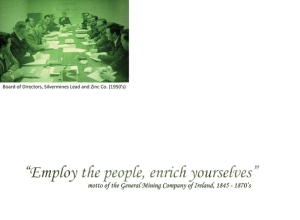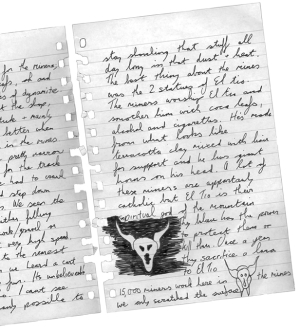First records of mine works at Shallee are in the 1790s when lead and silver was extracted and smelted onsite. In 1800 the owner of the land, Henry Sadlier Prittie was created Lord Dunally, and in 1802 the Dunally Mining Company was established with 11 principal shareholders. The company was not particularly successful (it wound up in 1804) and in 1845 a number of interests converged to set up the General Mining Company of Ireland (of which Lord Dunally was
a director).
“Employ the people, enrich yourselves” was the motto adopted by the General Mining Company of Ireland and records show that their employees ranged from 300 in 1849 to 700 in 1850 and 600 in 1853. 200 of these were men employed underground, 270 women and children working mostly at the surface and 170 tradesmen. By 1853 the ore near the surface had been exhausted; the editor of the Mining Journal made a visit to the mine in this year and found that miners were still being paid with meal, three years after the Famine had ended, and this mismanagement led to a miner’s strike that year. In 1854 miners sued the company for outstanding wages. Fortunes of the company fluctuated until 1870, when in a desperate attempt to raise money a subsidiary company, the Shallee Silver Lead Mining Company was set up. However, both ventures finally failed in the 1870s. Mining re-commenced in 1949 under the management of The Silvermines Lead and Zinc Company and these workings continued until 1953. The Shallee mine re-opened in 1955 and finally closed in 1958 having produced, during that period, in excess of 350,000 tonnes of ore. Although strikes were organised, mineworkers appear not to have been unionised until the period 1968 – 1982.
Source/ The Silvermines – Sporadic Working: 1289 – 1874 by Des Cowman, local conversations and artist notes
Artwork/ Fiona Woods & Clive Moloney
12/Front
Board of Directors, Silvermines Lead and Zinc Company, 1950’s. Artwork by Fiona Woods.

12/Back
Notes from visit to contemporary lead and silver mine, Bolivia by Clive Moloney, 2008.
“During my trip to the mining town of Potosi in South Bolivia I learned of El Tío, the spirit of the hills. El Tío takes the terrifying form of a human sized sculpture made from clay with cow horns on his head. He is found deep in the mines. In pre-Columbian times, the spirits that were embodied in natural landmarks were an important part of the social landscape. Health and good fortune were guaranteed for the community by entering into ritual relationships of sacrifice with the spirits – caring for the spirits ensured that the spirits would care for them. El Tío is not characterized by generosity, however. He is distinguished by his insatiable appetite. The miners must always think of that appetite and sacrifice llamas so that he will not claim human lives instead. Today, many miners continue to make small daily ritual sacrifices to El Tío (cigarettes, coca leafs, alcohol) in return for his protection in the mine while larger ceremonies are held following tragedies in the mines and on the appropriate days in the ritual calendar.”
